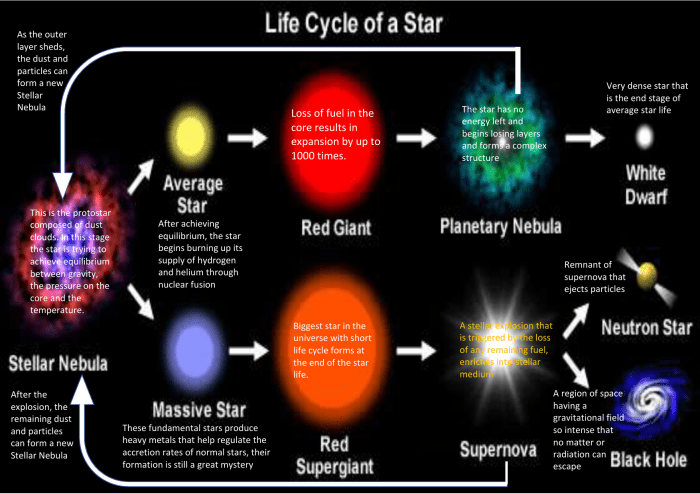Embark on a celestial journey with the Star Life Cycle Graphic Organizer, a meticulously crafted tool that unveils the intricate tapestry of stellar evolution. Delve into the dynamic stages of a star’s existence, from its incandescent birth to its enigmatic demise.
This comprehensive guide weaves together scientific rigor and visual clarity, empowering you to grasp the complex processes that shape the celestial landscape. Prepare to witness the birth of stars in molecular clouds, trace their evolution through nuclear fusion, and explore the awe-inspiring phenomena of supernovae and stellar remnants.
Star Life Cycle Stages

The life cycle of a star refers to the various stages it undergoes from its birth to its eventual death. Each stage is characterized by distinct physical and nuclear processes that shape the star’s evolution.
The following table provides a visual representation of the star’s life cycle:
| Stage | Description | Estimated Duration |
|---|---|---|
| Protostar | Formation of a star from a collapsing molecular cloud | 105
|
| Main Sequence | Stable phase where nuclear fusion powers the star | 109
|
| Red Giant | Expansion and cooling of the star as it exhausts its hydrogen fuel | 106
|
| White Dwarf | Remnant of a low-mass star after it sheds its outer layers | 109
|
| Neutron Star | Remnant of a massive star after a supernova explosion | Indefinite |
| Black Hole | Collapsed core of a massive star with immense gravitational pull | Indefinite |
Factors Affecting Star Life Cycle: Star Life Cycle Graphic Organizer
The lifespan and evolution of stars are influenced by several factors, including:
- Mass:More massive stars have shorter lifespans due to higher gravitational forces and faster fuel consumption.
- Composition:Stars with higher metallicity (elements heavier than helium) have longer lifespans.
- Environment:Interactions with other stars and the presence of binary companions can affect the star’s evolution.
Star Formation

Star formation begins with the collapse of a molecular cloud, a dense region of gas and dust. As the cloud collapses, it fragments into smaller clumps that form protostars.
Protostars are powered by gravitational energy as they continue to contract. As they reach a critical temperature and density, nuclear fusion ignites at their cores, marking the transition to a main-sequence star.
The following illustration depicts the different stages of star formation:
[Ilustrasi tahapan pembentukan bintang]
Nuclear Fusion and Energy Production

Nuclear fusion is the process that powers stars. In stars, hydrogen nuclei fuse to form helium, releasing vast amounts of energy.
The following table summarizes the different types of nuclear fusion reactions that occur in stars:
| Reaction | Fuel | Products |
|---|---|---|
| Proton-proton chain | Hydrogen | Helium-4 |
| CNO cycle | Hydrogen | Helium-4 |
| Triple-alpha process | Helium | Carbon |
Stellar Evolution
After the main-sequence phase, stars evolve through various paths depending on their mass:
- Low-mass stars:Evolve into red giants, white dwarfs, and eventually cool into black dwarfs.
- Intermediate-mass stars:Evolve into red giants, then shed their outer layers to form planetary nebulae and white dwarfs.
- Massive stars:Evolve into red supergiants, then undergo supernova explosions, leaving behind neutron stars or black holes.
The following flowchart illustrates the different evolutionary paths:
[Flowchart jalur evolusi bintang]
Supernovae and Stellar Remnants
Supernovae are powerful explosions that occur when massive stars reach the end of their lives. These explosions eject heavy elements into space, enriching the interstellar medium.
The remnants of supernovae can take various forms:
- Neutron stars:Extremely dense objects with a mass up to twice that of the sun.
- Black holes:Regions of spacetime with immense gravitational pull from which nothing can escape.
Impact on the Universe
Stars play a crucial role in the evolution of the universe:
- Nucleosynthesis:Stars produce heavy elements through nucleosynthesis, enriching the universe with elements beyond hydrogen and helium.
- Formation of planets and galaxies:Stars provide the gravitational pull necessary for the formation of planets and solar systems, and their collective mass contributes to the structure of galaxies.
Q&A
What is the significance of the star life cycle?
The star life cycle is crucial for understanding the evolution of the universe. Stars produce heavy elements through nucleosynthesis, which are essential for the formation of planets, solar systems, and galaxies.
How does nuclear fusion power stars?
Nuclear fusion is the process by which stars generate energy. In the core of a star, hydrogen atoms are fused together to form helium, releasing vast amounts of energy.
What is a supernova?
A supernova is a powerful explosion that occurs when a massive star reaches the end of its life. Supernovae release enormous amounts of energy and can create new elements.